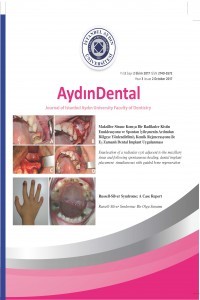PROLIFERATIVE VERRUCOUS LEUKOPLAKIA: FIVE YEARS FOLLOW-UP
lökoplaki, proliferative verrüköz lökoplaki, premalign lezyonlar, oral kanserler, verrüköz hiperplazi
PROLIFERATIVE VERRUCOUS LEUKOPLAKIA: FIVE YEARS FOLLOW-UP
leukoplakia, proliferative verrucous leukoplakia, potentially malignant disorders, oral cancer, verrucous hyperplasia,
___
- Lodi G, Sardella A, Bez C, Demarosi F, Carrassi A. Interventions for treating oral leukoplakia. The Cochrane database of systematic reviews. 2006(4):CD001829.
- Kumar A, Cascarini L, McCaul JA, Kerawala CJ, Coombes D, Godden D, et al. How should we manage oral leukoplakia? The British journal of oral & maxillofacial surgery. 2013;51(5):377- 83.
- Hansen LS, Olson JA, Silverman S, Jr. Proliferative verrucous leukoplakia. A long- term study of thirty patients. Oral surgery, oral medicine, and oral pathology. 1985;60(3):285- 98.
- Abadie WM, Partington EJ, Fowler CB, Schmalbach CE. Optimal Management of Proliferative Verrucous Leukoplakia: A Systematic Review of the Literature. Otolaryngology--head and neck surgery : official journal of American Academy of Otolaryngology-Head and Neck Surgery. 2015;153(4):504-11.
- Gillenwater AM, Vigneswaran N, Fatani H, Saintigny P, El-Naggar AK. Proliferative verrucous leukoplakia: recognition and differentiation from conventional leukoplakia and mimics. Head & neck. 2014;36(11):1662-8.
- Cerero-Lapiedra R, Balade-Martinez D, Moreno-Lopez LA, Esparza-Gomez G, Bagan JV. Proliferative verrucous leukoplakia: a proposal for diagnostic criteria. Medicina oral, patologia oral y cirugia bucal. 2010;15(6):e839- 45.
- Batsakis JG, Suarez P, el-Naggar AK. Proliferative verrucous leukoplakia and its related lesions. Oral oncology. 1999;35(4):354- 9.
- Pentenero M, Meleti M, Vescovi P, Gandolfo S. Oral proliferative verrucous leucoplakia: are there particular features for such an ambiguous entity? A systematic review. The British journal of dermatology. 2014;170(5):1039-47.
- Silverman S, Jr., Gorsky M. Epidemiologic and demographic update in oral cancer: California and national data--1973 to 1985. Journal of the American Dental Association. 1990;120(5):495- 9.
- Gandolfo S, Castellani R, Pentenero M. Proliferative verrucous leukoplakia: a potentially malignant disorder involving periodontal sites. Journal of periodontology. 2009;80(2):274-81.
- Silverman S, Jr., Gorsky M, Lozada F. Oral leukoplakia and malignant transformation.
- A follow-up study of 257 patients. Cancer. 1984;53(3):563-8.
- ISSN: 2149-5572
- Yayın Aralığı: Yılda 3 Sayı
- Başlangıç: 2015
- Yayıncı: İstanbul Aydın Üniversitesi
Engin Fırat ÇAKAN, Fatma YILDIRIM, Ahu TOPKARA
ENDODONTIC TREATMENT OF MANDIBULAR PREMOLAR WITH THREE CANALS USING CBCT
Seda AYDEMİR, Alper SİNANOĞLU, İşıl Kaya BÜYÜKBAYRAM, Göze ARUKASLAN
SINGLE NO-PREP PORCELAIN LAMINATE VENEER RESTORATIONS; 2 CASE REPORTS
Volkan TURP, Simel AYYILDIZ, Deniz ŞEN, Gülcan BAHARDIRLI
PULL-OUT STRENGTH OF FIBER POSTS LUTED WITH DIFFERENT SELF-ADHESIVES
NANOCERAMICS AND HYBRID MATERIALS USED IN CAD/CAM SYSTEMS
Nesrin CEREN, Volkan TURP, Faruk EMİR, Gökhan AKGÜNGÖR, Simel AYYILDIZ, Deniz ŞEN
PROLIFERATIVE VERRUCOUS LEUKOPLAKIA: FIVE YEARS FOLLOW-UP
Behçet EROL, Sercan KÜÇÜKKURT, Tuğçe Biçer AYTUGAR, Nihan AKSAKALLI
MUTAGENIC POTENTIAL OF A SELF-ADHESIVE FLOWABLE COMPOSITE
Tuğba TOZ, Zeliha AYDOĞAN, Duygu TUNCER, Emel KARAMAN
